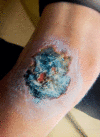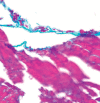Cutaneous Fusariosis in a Patient with Job's (Hyper-IgE) Syndrome
- PMID: 32607263
- PMCID: PMC7315260
- DOI: 10.1155/2020/3091806
Cutaneous Fusariosis in a Patient with Job's (Hyper-IgE) Syndrome
Abstract
Fusarium is a filamentous fungus that is ubiquitous in nature and can cause severe opportunistic infections in immunocompromised hosts. The association between Fusarium and hyper-IgE syndrome is exceedingly rare and has only been documented in a single report previously. A 44-year-old male, working as marijuana grower, with prior diagnosis of hyper-IgE syndrome and recurrent infections presented with enlarging right knee ulcer that did not respond to antimicrobial treatment. The patient was diagnosed with cutaneous fusariosis, confirmed with punch biopsy and positive wound cultures. The patient was managed with extended antifungal therapy (i.e., posaconazole) and surgical debridement resulting in remarkable improvement with wound healing leaving a pale scar. Fusarium should be considered in differential for cutaneous and invasive fungal infections in presence of cutaneous manifestations. Exposure to Cannabis plants is a noticeable risk factor. Multimodal approach involving systemic antifungals and wound debridement is essential for favorable outcome. Posaconazole was demonstrated to be a highly efficacious antifungal choice.
Copyright © 2020 Ahmed M. Altibi et al.
Conflict of interest statement
The authors declare that there are no conflicts of interest.
Figures




Similar articles
-
Primary Invasive Cutaneous Fusariosis in Patients with STAT3 Hyper-IgE Syndrome.J Clin Immunol. 2023 Apr;43(3):647-652. doi: 10.1007/s10875-022-01404-4. Epub 2022 Dec 12. J Clin Immunol. 2023. PMID: 36504258
-
Cutaneous fusariosis by a species of the Fusarium dimerum species complex in a patient with acute myeloblastic leukemia.Rev Iberoam Micol. 2013 Apr-Jun;30(2):119-21. doi: 10.1016/j.riam.2012.11.001. Epub 2012 Nov 20. Rev Iberoam Micol. 2013. PMID: 23178711
-
[Fusariosis diagnosed in the laboratory of an UH in Tunisia: epidemiological, clinical and mycological study].J Mycol Med. 2013 Jun;23(2):130-5. doi: 10.1016/j.mycmed.2013.04.003. Epub 2013 May 30. J Mycol Med. 2013. PMID: 23725904 French.
-
Dermatologic presentations of hyper IgE syndrome in pediatric patients.Allergy Asthma Clin Immunol. 2025 May 2;21(1):20. doi: 10.1186/s13223-025-00963-6. Allergy Asthma Clin Immunol. 2025. PMID: 40317072 Free PMC article. Review.
-
[A Case of Cutaneous Fusariosis of the Scrotum as a Complication of Acute Myeloid Leukemia].Med Mycol J. 2016;57(2):J65-70. doi: 10.3314/mmj.57.J65. Med Mycol J. 2016. PMID: 27251318 Review. Japanese.
Cited by
-
Fungal and mycotoxin contaminants in cannabis and hemp flowers: implications for consumer health and directions for further research.Front Microbiol. 2023 Oct 19;14:1278189. doi: 10.3389/fmicb.2023.1278189. eCollection 2023. Front Microbiol. 2023. PMID: 37928692 Free PMC article. Review.
-
Hyalohyphomycosis (Fusariosis): Atypical Presentation in an Immunocompetent Individual Responding to Itraconazole.Indian Dermatol Online J. 2023 Aug 10;15(2):263-265. doi: 10.4103/idoj.idoj_80_23. eCollection 2024 Mar-Apr. Indian Dermatol Online J. 2023. PMID: 38550822 Free PMC article.
References
Publication types
LinkOut - more resources
Full Text Sources

